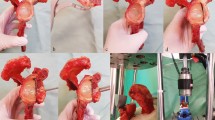Abstract
Introduction
A commonly used method of fixation of the transferred coracoid in the traditional Latarjet–Bristow procedure (open or arthroscopic) is by two bicortical screws. Although mechanically effective, screw fixation is also a major source of hardware and neurologic complications. This study aimed to compare the biomechanical performances of traditional metal screws and endobuttons as fixators of the Latarjet–Bristow procedure.
Materials and methods
Nine fresh-frozen cadaveric human scapulae with the conjoined tendon attached to the coracoid process were used for the Latarjet–Bristow procedure. The specimens were randomly assigned one of two groups: fixation using two 4.5-mm cannulated partially threaded Latarjet–Bristow experience screws or fixation using a suture-button construct. Specimens were secured in a material testing machine and cyclically preconditioned from 2 to 10 N at 0.1 Hz for ten cycles. They were then pulled to failure at a normalized displacement rate of 400% of the measured gauge length per minute. The maximal load-to-failure, stiffness and stress were calculated using a custom script. The failure mechanism and site were recorded for each specimen.
Results
There were no significant differences in the maximal load-to-failure or other biomechanical properties of the two fixation techniques, but the failure mechanisms were unique to each one. Four specimens fixated with screws underwent graft failures (fracture) through the proximal or distal drill hole. Five specimens fixated with endobuttons underwent failure due to glenoid bone fractures.
Conclusions
A single endobutton fixation appears to be biomechanically comparable to screw fixation in the Latarjet–Bristow procedure and provides a lower risk for graft fracture. Further studies with more numerous specimens are warranted to conclusively validate these findings.




Similar content being viewed by others
References
Shields DW, Jefferies JG, Brooksbank AJ, Millar N, Jenkins PJ (2018) Epidemiology of glenohumeral dislocation and subsequent instability in an urban population. J Shoulder Elbow Surg 27(2):189–195. https://doi.org/10.1016/j.jse.2017.09.006
Bessiere C, Trojani C, Pelegri C, Carles M, Boileau P (2013) Coracoid bone block versus arthroscopic Bankart repair: a comparative paired study with 5-year follow-up. Orthop Traumatol Surg Res 99(2):123–130. https://doi.org/10.1016/j.otsr.2012.12.010
Willemot L, De Boey S, Van Tongel A, Declercq G, De Wilde L, Verborgt O (2018) Analysis of failures after the Bristow–Latarjet procedure for recurrent shoulder instability. Int Orthop. https://doi.org/10.1007/s00264-018-4105-6
Provencher MT, Aman ZS, LaPrade CM, Bernhardson AS, Moatshe G, Storaci HW, Chahla J, Turnbull TL, LaPrade RF (2018) Biomechanical comparison of screw fixation versus a cortical button and self-tensioning suture for the Latarjet procedure. Orthop J Sports Med 6(6):2325967118777842. https://doi.org/10.1177/2325967118777842
Shin JJ, Hamamoto JT, Leroux TS, Saccomanno MF, Jain A, Khair MM, Mellano CR, Shewman EF, Nicholson GP, Romeo AA, Cole BJ, Verma NN (2017) Biomechanical analysis of Latarjet screw fixation: comparison of screw types and fixation methods. Arthroscopy 33(9):1646–1653. https://doi.org/10.1016/j.arthro.2017.03.030
Gendre P, Thelu CE, d'Ollonne T, Trojani C, Gonzalez JF, Boileau P (2016) Coracoid bone block fixation with cortical buttons: an alternative to screw fixation? Orthop Traumatol Surg Res 102(8):983–987. https://doi.org/10.1016/j.otsr.2016.06.016
Alvi HM, Monroe EJ, Muriuki M, Verma RN, Marra G, Saltzman MD (2016) Latarjet fixation: a cadaveric biomechanical study evaluating cortical and cannulated screw fixation. Orthop J Sports Med 4(4):2325967116643533. https://doi.org/10.1177/2325967116643533
Schmiddem U, Hawi N, Liodakis E, Dratzidis A, Kraemer M, Hurschler C, Page R, Meller R (2018) Monocortical fixation of the coracoid in the Latarjet procedure is significantly weaker than bicortical fixation. Knee Surg Sports Traumatol Arthrosc. https://doi.org/10.1007/s00167-018-4837-2
Cole BJ, Sayegh ET, Yanke AB, Chalmers PN, Frank RM (2016) Fixation of soft tissue to bone: techniques and fundamentals. J Am Acad Orthop Surg 24(2):83–95. https://doi.org/10.5435/JAAOS-D-14-00081
Butt U, Charalambous CP (2012) Complications associated with open coracoid transfer procedures for shoulder instability. J Shoulder Elbow Surg 21(8):1110–1119. https://doi.org/10.1016/j.jse.2012.02.008
Valenti P, Maroun C, Wagner E, Werthel JD (2018) Arthroscopic Latarjet procedure combined with bankart repair: a technique using 2 cortical buttons and specific glenoid and coracoid guides. Arthrosc Tech 7(4):e313–e320. https://doi.org/10.1016/j.eats.2017.09.009
Mazzocca AD, Burton KJ, Romeo AA, Santangelo S, Adams DA, Arciero RA (2007) Biomechanical evaluation of 4 techniques of distal biceps brachii tendon repair. Am J Sports Med 35(2):252–258. https://doi.org/10.1177/0363546506294854
Ahmad CS, Gardner TR, Groh M, Arnouk J, Levine WN (2004) Mechanical properties of soft tissue femoral fixation devices for anterior cruciate ligament reconstruction. Am J Sports Med 32(3):635–640. https://doi.org/10.1177/0363546503261714
Spang JT, Weinhold PS, Karas SG (2006) A biomechanical comparison of EndoButton versus suture anchor repair of distal biceps tendon injuries. J Shoulder Elbow Surg 15(4):509–514. https://doi.org/10.1016/j.jse.2005.09.020
Milano G, Mulas PD, Ziranu F, Piras S, Manunta A, Fabbriciani C (2006) Comparison between different femoral fixation devices for ACL reconstruction with doubled hamstring tendon graft: a biomechanical analysis. Arthroscopy 22(6):660–668. https://doi.org/10.1016/j.arthro.2006.04.082
Boileau P, Saliken D, Gendre P, Seeto BL, d'Ollonne T, Gonzalez JF, Bronsard N (2019) Arthroscopic Latarjet: suture-button fixation is a safe and reliable alternative to screw fixation. Arthroscopy. https://doi.org/10.1016/j.arthro.2018.11.012
Funding
There is no funding source.
Author information
Authors and Affiliations
Corresponding author
Ethics declarations
Conflict of interest
The authors declare that they have no conflict of interest.
Ethical approval
In-vitro biomechanical study.
Additional information
Publisher's Note
Springer Nature remains neutral with regard to jurisdictional claims in published maps and institutional affiliations.
Rights and permissions
About this article
Cite this article
Kazum, E., Chechik, O., Pritsch, T. et al. Biomechanical evaluation of suture buttons versus cortical screws in the Latarjet–Bristow procedure: a fresh-frozen cadavers study. Arch Orthop Trauma Surg 139, 1779–1783 (2019). https://doi.org/10.1007/s00402-019-03269-6
Received:
Published:
Issue Date:
DOI: https://doi.org/10.1007/s00402-019-03269-6




